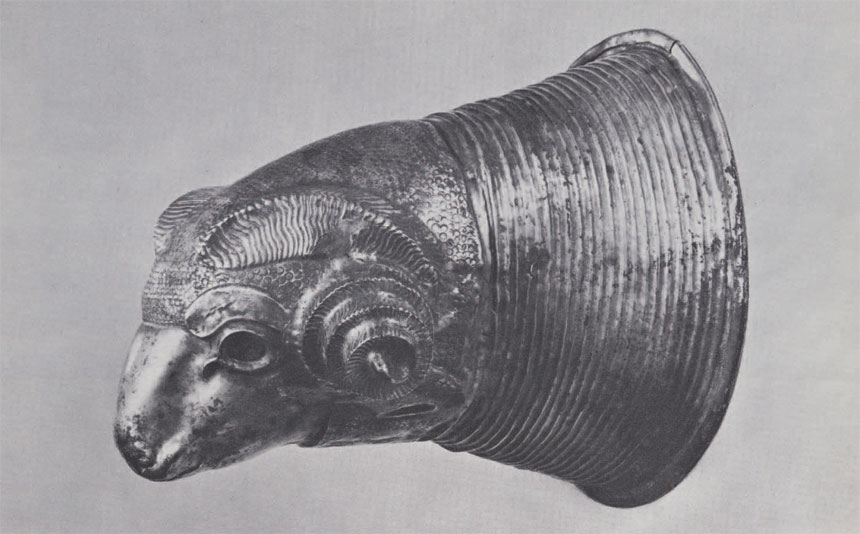The mountains of western Iran are today the home of sheep-herding tribesmen as they have been since animals were first domesticated. It is not surprising, therefore, that both domestic sheep and their local wild relatives have provided motifs for Iranian art from early prehistoric times. In the pre-metal ages they were painted on pottery; in later periods they appear cast in the round or in repoussee on many handsome objects of bronze.

This silver rhyton, or drinking vessel, recently purchased by the Museum, comes from this western mountain area of Iran and illustrates many of the features characteristic of the style in-vogue there during the eighth and seventh centuries B.C. Looking at the vessel, one sees the head of a ram with tightly curled horns and a neck that flares out to an open end. The neck is executed in the form of a purely decorative series of horizontal flutings of the type common to the Achaemenian art of the following centuries. The drinking edge is finished off with a simple fold of the metal. The lower end of the neck joins the head with an abrupt transition to conventionalized fleece, indicated by simple circles impressed with an annular drill. The effect is that of two separate pieces joined, but in fact only a single piece of silver was used.
The termination of the fleece in a straight line between the eyes draws attention to the great width separating the base of the horns, themselves emphasized by a rather triangular treatment. In spacing and styling, the horns depart from their natural condition where they are usually close together with flattened bases. The use of three complete turns, the tightness of the coil, and the protrusion from the head are also liberties taken by the artist, producing a geometric effect in what pretends to be a natural representation. The excessive protrusion of the horns allows them to serve as handles when holding the rhyton.
The smooth face and bold eyes form a neat contrast to the elaboration of fleece and horns. The deep eyes, probably originally inlaid, are reinforced by the large, conventionalized eyebrows and exaggerated tearducts. The two appendages below the horns appear to be drooping ears made visible by the artificially tight curl of the horns.
Animal-headed drinking vessels are widespread in the Near East during the first millennium B.C., having been found at Ziwiye in Iran, Khorsabad and Nimrud in Assyria, and as far west as classical Greece. Recently two magnificent specimens in bronze, but of a slightly different type, were unearthed by the Museum’s Expedition to Gordion in Turkey. All of these animal-headed vessels provide us with an excellent opportunity to study the interplay of factual knowledge and imagination in the minds of the artists of the ancient world, and demonstrate the high development of their craftsmanship.
